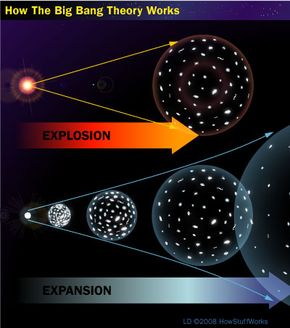The Short and Skinny on the Big Bang
The big bang theory describes the development of the universe from the time just after it came into existence up to today. It's one of several scientific models that attempts to explain why the universe is the way it is. The theory makes several predictions, many of which have been proven through observational data. As a result, it's the most popular and accepted theory regarding our universe's development.
The most important concept to get across when talking about the big bang is expansion. Many people think that the big bang is about a moment in which all the matter and energy in the universe was concentrated in a tiny point. Then this point exploded, shooting matter across space, and the universe was born. In fact, the big bang explains the expansion of space itself, which in turn means everything contained within space is spreading apart from everything else. The illustrations below should help a little.
Advertisement
Today, when we look at the night sky, we see galaxies separated by what appears to be huge expanses of empty space. At the earliest moments of the big bang, all of the matter, energy and space we could observe was compressed to an area of zero volume and infinite density. Cosmologists call this a singularity.
What was the universe like at the beginning of the big bang? According to the theory, it was extremely dense and extremely hot. There was so much energy in the universe during those first few moments that matter as we know it couldn't form. But the universe expanded rapidly, which means it became less dense and cooled down. As it expanded, matter began to form and radiation began to lose energy. In only a few seconds, the universe formed out of a singularity that stretched across space.
One result of the big bang was the formation of the four basic forces in the universe. These forces are:
- Electromagnetism
- Strong nuclear force
- Weak nuclear force
- Gravity
At the beginning of the big bang, these forces were all part of a unified force. It was only shortly after the big bang began that the forces separated into what they are today. How these forces were once part of a unified whole is a mystery to scientists. Many physicists and cosmologists are still working on forming the Grand Unified Theory, which would explain how the four forces were once united and how they relate to one another.
